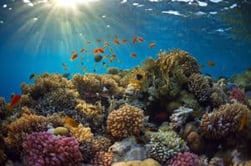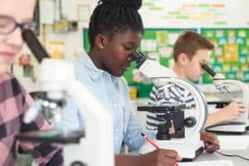Hurricanes Inquiry Lab
Middle School Inquiry Lab on Hurricanes
In this lab students will track the pathway of some of the most famous hurricanes in history and draw conclusions about hurricane formation and travel based on patterns they identify in their map.
Each inquiry lab will contain an essential question that will drive the lesson and make students think. For this lesson, the essential question is:
- How do oceans affect hurricanes?
BACKGROUND INFORMATION AND MATERIALS LIST:
Students will begin the lab by reading the essential question and background information. This can be done individually, as lab groups, or as a whole class. If you consider lab groups, you also might include some type of whole class formative checks before digging into the lab.

Materials List:
- colored pencils
- blank Atlantic tracker maps
- sea surface temperature page
- hurricane data pages 1 and 2
- plastic wrap
- ice water
- warm water
- heat lamp
- 3 small beakers
- dirt
PROCEDURE:
For this lab, students will complete two portions of the lab to better understand the ocean’s influence on developing hurricanes. In part one, students will set up three different beakers - one with soil, one with cold water, one with warm water - and place them under a heat lamp. While the beakers are under the lamp, students will have to take temperature readings every minute for 5 minutes. Students will then have to decide which type of beaker best supports a hurricane.
In part two, students will decide on two famous hurricanes and, using two different colored pencils, they will plot their courses as they moved through the Atlantic Ocean. When students have completed plotting the courses, they will analyze the temperatures of the storm from when it originated and when it faded.
CHECK FOR UNDERSTANDING:
At this point in the lab, students will be checked for understanding by answering questions about their findings. Here are a few that come with the lab:
- Which sample evaporated more easily, releasing the moisture that would keep a hurricane going?
- How might the differences in evaporation affect a hurricane traveling over areas of land, cold water, and warm water?
- How did the hurricanes’ behavior match up with your predictions about the effects of evaporation?
CONCLUSION
Students will go back to the essential question and write a CER (Claim, Evidence, Reasoning) to conclude the lab. Once completed, students will reflect back on their learning by answering the following questions:
- Describe how a hurricane begins.
- What is different about the storm moving over land as opposed to it moving over water?
- If the ocean surface temperature suddenly dropped to 65°F, how would a developing hurricane be affected?
MODIFIED AND INDEPENDENT INQUIRY VERSIONS
All of the Kesler Science inquiry labs come with three different modification levels. Each lab is differentiated using the icons below.
STANDARDS ALIGNMENT
TEKS: 8.10C – Identify the role of oceans in the formation of weather systems such as hurricanes.

Download Over $100 in FREE Resources
For Middle School Science
Simply create a login below and gain immediate access to a selection of our Kesler Science product line worth $100 - for FREE. There's a full version of every product type! You'll also join tens of thousands of middle school science teachers who receive timely tips and strategies straight to their inbox.





